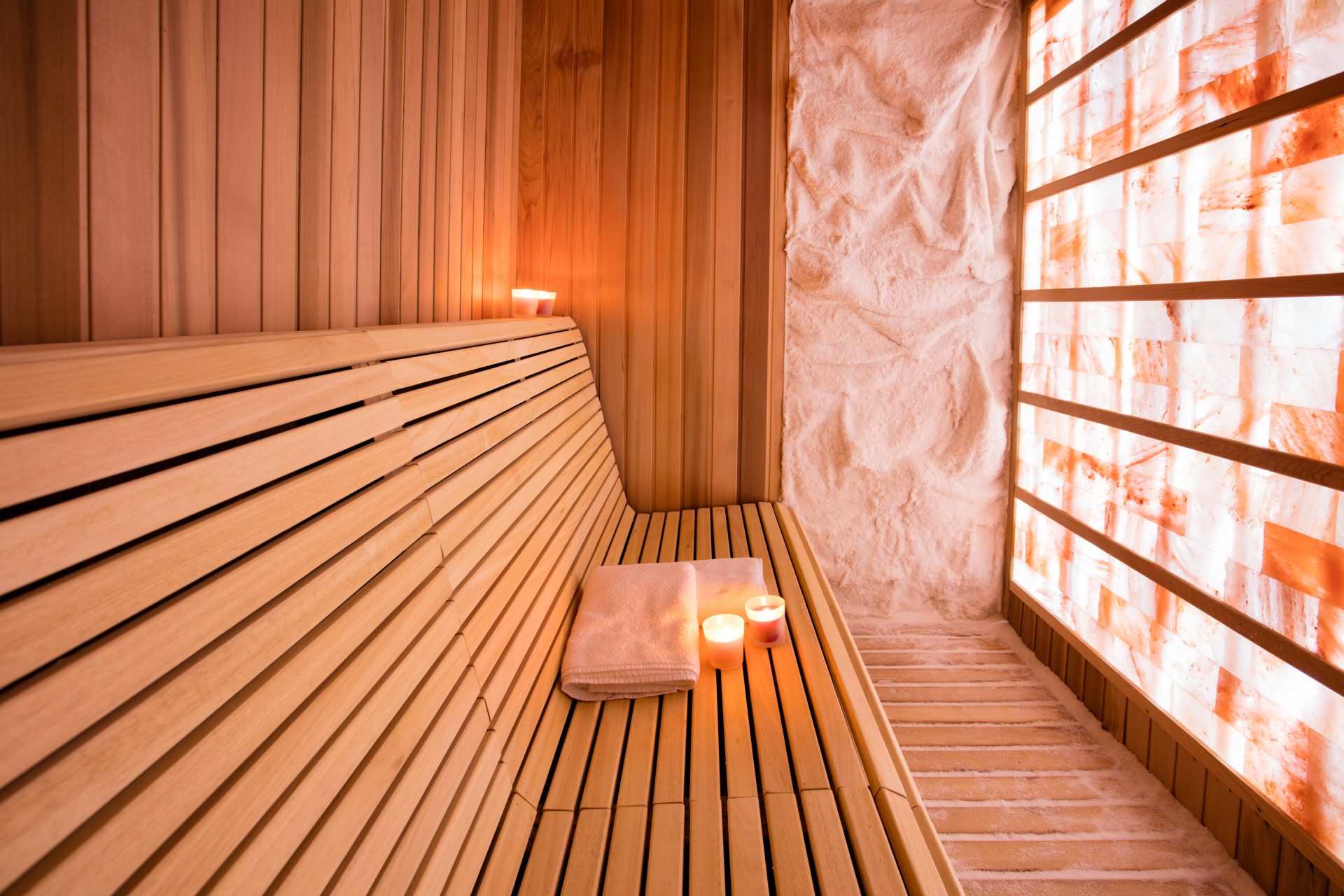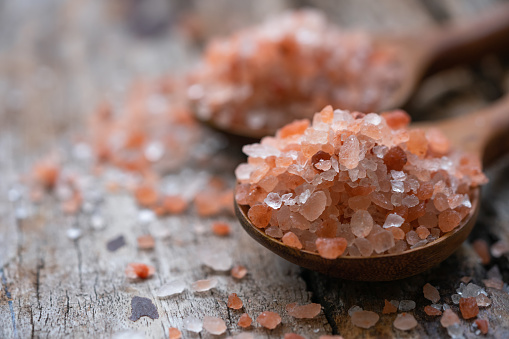
We’ve gone wild for saunas, plunged ourselves into freezing cold water and now the latest alternative “eco-therapy” treatment has us sitting in salt caves. But is halotherapy really good for us? Here’s what you need to know…
My halotherapy journey (or should I call it an obsession? I’ve been three weeks in a row) started with a text. “Btw, have you heard of the Earlsfield Salt Cave?” came the ping from my friend a few weeks ago, followed by a link to a Groupon voucher which offered two hour-long salt therapy sessions for £20.
She’d tried it a couple of times on the recommendation of a GP friend, hoping that sitting in a room which uses dry salt aerosol technology to mimic the environment of a natural salt cave (and has a temperature between 22 and 25°C) would help with her tricky-to-kick bronchitis. “If nothing else, it’s a chance to sit down for an hour,” she messaged. “Plus, it might be good for the skin.”
I was congested, stressed and mid-breakout, so it didn’t take much convincing. I’m not sure what I was expecting…but it wasn’t to walk into a room with salt walls and flooring, deck chairs scattered around, relaxing music playing. You could burrow under a blanket, browse a magazine, blow your nose into tissues provided at each seat (sitting in that room will make your nose run).
You may also like
Do ice baths help exercise recovery? Here’s why anti-inflammatory cryotherapy isn’t good after training
Stylish, it isn’t: you have to cover your hair with a disposable shower cap before entering the room, put those blue plastic things on your shoes, or go barefoot. When you come out, your clothes are covered in a fine dusting of white powder. And you can’t talk on the phone or chat to anyone for the duration of the 60-minute slot. You’re forced to sit. To read. To chill out. To relax…
And yes, it’s kind of awesome. But does it actually do anything?
Halotherapy: what is salt therapy and how can you do it?
Halotherapy, AKA salt therapy, is having a moment (a 3 billion-views-and-counting-on-TikTok kind of a moment). Salt rooms can be found all around the UK, from Hertfordshire to Lanarkshire.
In addition to the salt cave experience I’ve been doing, which uses something called Breeze Tronic Pro technology to replicate a salt cave microclimate in a regular old building on your local high street, you can also explore Himalayan salt wall saunas (which typically include a wall made from pretty pink salt bricks), now a coveted feature in top spas like the Four Seasons Park Lane in London and the new Six Senses Crans-Montana in Switzerland. The US goes even further: San Francisco has its own Himalayan salt yoga studio.
But salt therapy is nothing new.
“Halotherapy, or salt therapy as it’s also known, involves breathing in air with tiny salt particles to improve your breathing,” explains energy and emotions expert, Antonia Harman. “While this is being seen as a new healing treatment, it’s actually been around since the 12th century, where visiting salt rooms or salt caves was very common in Eastern Europe for therapeutic reasons.”
Our modern-day understanding of the practice of using speleotherapy (aka salt mine treatments) goes back to the 1800s, when a Polish physician discovered that Polish salt miners weren’t experiencing the typical respiratory issues associated with the job.
What are the main benefits of salt therapy?
It’s supposed to hold spiritual benefits
“Spiritually, salt has a lot of healing benefits, protective properties and also represents purification,” explains Harman. “It plays a key role in the body’s natural functions as well as in nature. Salt is closely tied, along with water, to the origins of life. Healing starts from within and there are no more powerful properties than driving your own healing journey internally, using minerals and nature that have been on earth since the beginning of time.”
Breathing in salt makes it easier to get rid of mucus
Science-wise, dry salt inhalation has been found to decrease inflammation, dissolve mucus and make it easier and faster to get rid of air pollution or allergen particles.

It’s great for sleep and relaxation
If you’re thinking halotherapy sounds a bit like those other therapies we’ve been getting obsessive about lately (cryotherapy, thermotherapy, infrared therapy), then you’re right: like other eco-therapies, part of its appeal and popularity comes from the idea that immersing ourselves deeply in nature can help heal our various ailments.
Dr Nerina Ramlakhan, a physiologist, sleep and energy expert who recently visited the salt mines in Katowice, Poland and describes her experience there as “profound”, believes there can be “great therapeutic benefits” to halotherapy in terms of relaxation, recovery and, ultimately, sleep. She says that we’re all seeking antidotes from the constant stress, anxiety, burnout and uncertainty in the world around us. For many of us, rediscovering the powers of nature is one way to stay balanced.
“Our world is so noisy and busy that we’re needing even more help to take us deeper into ourselves, particularly in light of the pandemic. In the wake of Covid, lots of people are still trying to recover their mental capacity and physiological capacity,” Dr Ramlakhan says.
By putting us in a space where we’re pretty much forced to relax, halotherapy does help settle our minds (Dr Ramlakhan notes that while some people believe constant restlessness in the day leads to better sleep at night, that’s not the case). “We need to be restful in our waking hours in order to access rest when we sleep at night,” she says.
You may also like
Do ice baths help exercise recovery? Here’s why anti-inflammatory cryotherapy isn’t good after training
Dr Ramlakhan continues that flotation tanks (a form of sensory deprivation therapy, which involves immersion in Epsom salts and water) are also becoming increasingly popular.
“They help you to let go. That’s the thing that people find so difficult. Letting go of the day, letting go of stress. Being in an environment where there’s a kind of sensory deprivation, but there’s a chemical balance that promotes more relaxation and better breathing, all of that is going to help with the relaxation process and the letting-go process.” For those who can’t get to a tank or a salt room, she recommends adding Epsom salts to the bath to help relax muscles (they can also help with sleep).
“We are gravitating towards natural healing therapies because they work. From forest bathing to cold water therapy, the list is endless,” adds Harman. “In a society that tells us we ‘need’ the latest gadgets or material goods, people are now moving away from that level of consumerism and finding solace and fulfilment in the ordinary and nature. It’s sustainable healing and it’s something we all have access to and can tap into every single day.”
Is there any science behind apparent salt therapy benefits?
Salt therapy sounds just lovely, doesn’t it? But can it actually help with chronic obstructive pulmonary disease (COPD), asthma, eczema and all of the respiratory and skin conditions it’s purported to? Head to any salt room and you’ll find binders full of testimonials from converts who will tell you how salt therapy has eased respiratory discomfort or helped with arthritis. But here’s the thing: much of the evidence is anecdotal… and even the research should be taken with a pinch of salt (see what we did there?).
One of the biggest claims when it comes to salt therapy is that it can help with COPD symptoms, such as coughs and respiratory infections. Considering experts are referring to autumn/winter 2022-23 as a “tripledemic” (the unpalatable combination of Covid, flu and RSV), it’s understandable we’re looking for alternative remedies to bolster our immune systems.
You may also like
“Do I have a cold, Covid or strep A?” Here’s how to tell and what to do if you think you’ve got strep A
The science doesn’t back up halotherapy as a respiratory remedy quite yet: a 2014 review of studies done on salt therapy for COPD determined that “recommendations for inclusion of halotherapy as a therapy for COPD cannot be made at this point”.
However, nasal irrigation with hypertonic saline (saline solution inhaled into the lungs) is used in hospitals to help with common cold symptoms, and backed up by research. “It can help relieve discomfort from excess sputum and break down thick secretions in the sinuses and lungs,” explains Mr Hassan Elhassan, a nose and sinus surgeon at London Bridge Hospital, part of HCA Healthcare UK.
“It is also prescribed for the treatment of bronchiolitis and bronchiectasis, where it helps with wheezing and loosening mucus.”
He urges anyone with asthma and COPD to consult their doctor before trying halotherapy and dissuades anyone with heart problems or high blood pressure from using salt rooms (salt is known to increase blood pressure and could worsen those conditions).
“Inhaling salt can also irritate your airways, which can cause coughing and trigger asthma attacks. Currently most experts do not recommend salt therapy for people with asthma,” notes Emma Rubach, head of health advice at Asthma + Lung UK.
Halotherapy for pain relief is yet another area that’s inconclusive, explains Dr Deepak Ravindran, clinical lead for pain management at the Royal Berkshire Hospital.
“At present, there is not enough evidence to refer patients for salt therapy in terms of pain reduction. It is important people understand that this holistic therapy is not based in evidence like cold water exposure. If patients find going to a halotherapy room is calming for their anxiety and stress levels it is something they can explore, but this would be for personal relaxation purposes and should not stem from evidence-based information because there is not the data to back this offering up as of yet for pain management,” he says.
However, salt therapy has been shown to be beneficial for skin conditions, from eczema to acne, psoriasis to atopic dermatitis, notes Mr Elhassan. “Halotherapy can be used for its positive effects on skin conditions such as eczema, dermatitis and acne. As salt is naturally antibacterial, it can reduce inflammation and swelling and acts as a gentle exfoliator,” he says.

Then again, if you want to relax and escape the grind of the day, then heading to your local halotherapy clinic might just be worth its salt: “It may be used as relaxing spa treatment (which could have a placebo effect), as opposed to relying on this as a medical treatment to clear the nose and sinuses. The placebo effect is real and is known to help people get better. We may not have the science to explain it all at this stage but it doesn’t mean it’s not there,” Mr Elhassan adds.
As for me, I think I’ll keep going (as long as I can get some more of those £10 slots). I’ve been “sandwiching” my salt room sessions with a run on one side and a lengthy walk on the other. Sunlight on my skin, wind on my cheeks, glorious views of trees and grass and sky. Eco-therapy indeed.
Images: Getty
Source: Read Full Article